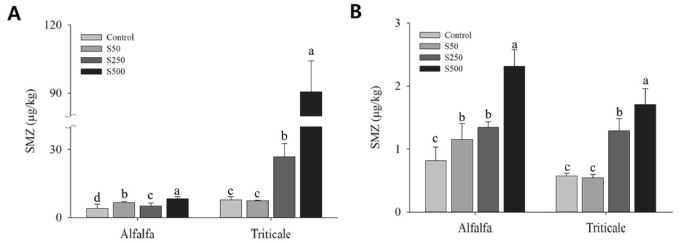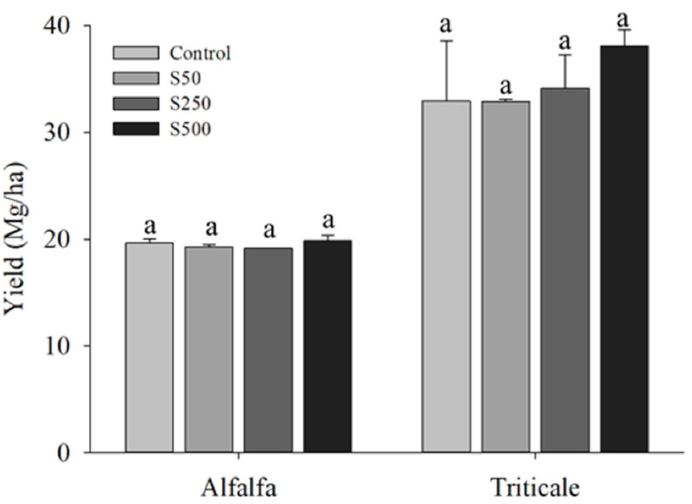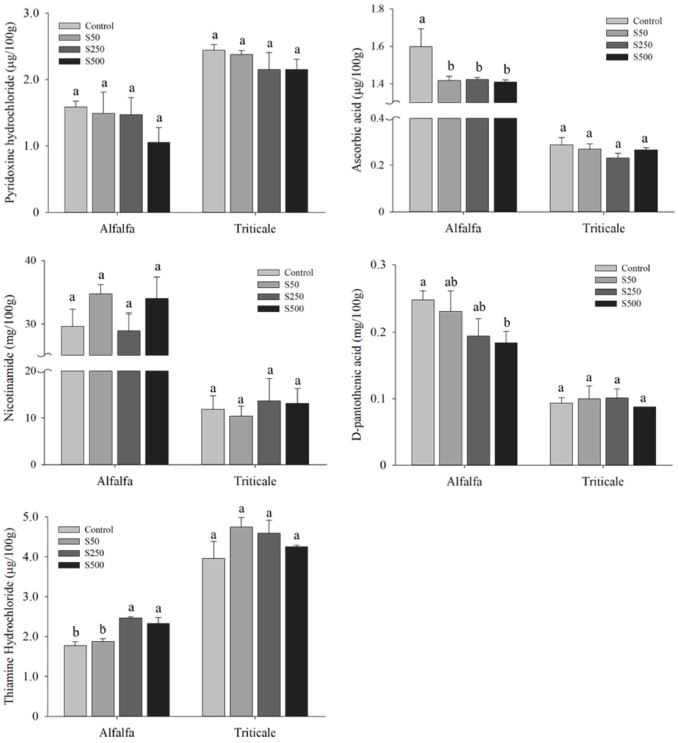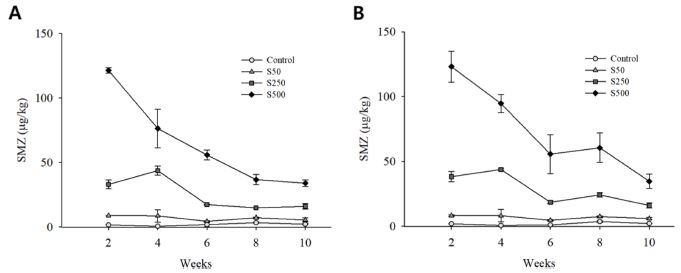
토양 중 Sulfamethazine이 알팔파 및 트리티케일의 생육 및 품질에 미치는 영향
 ; Yong Bok Lee1, 2, *
; Yong Bok Lee1, 2, *
초록
전 세계적으로 농업토양의 가축분뇨 시비를 통해 토양 항생제오염이 유발되고 있으며 이에 따라 토양생태계 및 인간건강에 대한 환경위험도가 증가되고 있다. 본 연구는 토양 중 잔류 Sulfamethazine (SMZ)이 알팔파와 트리티케일 작물로의 흡수가능성을 알아보고, 작물 생육과 품질에 미치는 영향을 평가하고자 pot 시험을 수행하였다. 토양 중 SMZ 농도수준을 설정하기 위해 비료원인 가축퇴비에 SMZ을 0 (control), 50 (S50), 250 (S250) 및 500 (S500) mg/kg 수준으로 처리하였고, 이를 파종 1주전 pot 토양에 시비한 후 2달간 두 사료작물을 재배하였다. SMZ의 처리수준이 높을수록 토양 중 SMZ 잔류농도가 높았으며 시간변화에 따른 감소폭도 컸다. 이러한 SMZ 처리구간 차이는 두 작물 내 SMZ 축적량에서도 유사하게 나타났다. 고농도 처리구인 S500의 경우, 알팔파의 지하부 및 지상부의 SMZ 농도가 각각 8.20 및 2.31 μg/kg이였고, 트리티케일은 각각 90.6 및 1.70 μg/kg으로 나타났다. 대조구를 제외한 모든 SMZ 퇴비처리구의 bioaccumulation factor (soil-shoot) 값이 0.1 이하로 두 작물 가식부로의 SMZ 흡수 및 전이가 높지 않은 것으로 나타났다. 알팔파의 경우, SMZ 고농도 처리구에서 식물체내 질소와 비타민 종인 ascorbic acid 및 D-pantothenic acid 함량이 감소되었는데 이는 SMZ 처리에 의해 사료작물로써 영양학적 가치가 저하된 것으로 보인다. 반면 thiamine hydrochloride (비타민 B1)은 SMZ 고농도 처리구에서 증가하였는데 이는 SMZ 독성스트레스에 대한 내성기작 요소로 작용하여 작물의 생육발달과 생산성에 대한 피해를 완화시킨 것으로 사료된다.
Abstract
Globally, antibiotics are added to agricultural soils through livestock manure application, causing antibiotic contamination and subsequent increasing environmental risks to terrestrial ecosystem and human health. This study was conducted to investigate how residual sulfamethazine (SMZ) in soil affects the growth and quality of alfalfa and triticale crops through a 2-month pot experiment. Four different SMZ levels of livestock compost, including 0 (control), 50 (S50), 250 (S250) and 500 (S500) mg/kg, were applied to pot soils one week before sowing. The SMZ contamination level of the soil seemed to be determined by the SMZ levels of the treated compost and then decreased over time in all treatments. Similarly, such difference among the treatments was found in SMZ content of two crop species. In S500 treatment, the SMZ concentrations in roots of alfalfa and triticale were 8.20 and 90.6 μg/kg, respectively, while those in their shoots were 2.31 and 1.70 μg/kg, respectively. In addition, low values of bioaccumulation factor, less than 0.1, estimated in S250 and S500 treatments may indicate that the SMZ antibiotic accumulated in the soil is not highly likely to be absorbed and transferred to edible parts of the two crops. Of the crops, alfalfa had significantly lowered contents of nitrogen and vitamins (ascorbic acid and D-pantothenic acid) in S250 and S500, compared to control. On the other hand, thiamine hydrochloride as vitamin B1 increased in these two SMZ treatments. It is thought that the increase in such metabolite might serve to promote the plant resistance to SMZ toxicity, mitigating potential damage to crop growth and productivity.
Keywords:
Livestock compost, Antibiotic contamination, Crop productivity, Vitamins, Silage quality키워드:
가축퇴비, 항생제 오염, 작물생산성, 비타민, 조사료 품질서 론
전 세계적으로 연간 100,000~200,000톤의 항생제가 소비되고 있으며, 최근 20년동안 총 항생제 소비량은 46% 이상 증가하였다(Hofer, 2021). 대부분의 항생제는 인간의 치료목적으로 사용되고 있으며, 그 외 축산업 분야에서도 많은 양이 소비되고 있다. 가축종류별 연평균 항생제 사용량은 소, 닭, 돼지가 각각 45, 148, 172 mg/kg으로 알려져 있다(Van Boeckel et al., 2014). 최근 국내에서는 육류 소비의 증가로 집약형 밀집사육 농가가 증가하고 있다. 이러한 사육환경 조건에서 효율적으로 가축병을 예방하고 생산성을 높이기 위해 chlortetracycline, sulfonamide 등의 항생제가 사용되고 있다(Conde-Cid et al., 2020). Kim et al. (2011)에 따르면 국내 가축 항생제 사용량은 영국, 덴마크 등 외국의 사용량보다 88~1000배 많은 것으로 보고되었다. 이러한 국내 축산농가의 과도한 항생제 소비는 주변 토양 및 수질환경에 상당한 양의 항생제 유입을 발생시키고 있으며, 이렇게 축적된 항생제는 자연생태계에서 독성물질로써 작용하고 있다(Apreja et al., 2021). 또한, 자연환경 중 항생제 내성균 증가는 인간 건강과 관련하여 최근 이슈화되고 있어(Peng et al., 2021), 적절한 사용과 관리방안이 시급히 요구된다.
최근 축산물 소비량의 증가로 국내 가축 사육두수가 급격히 증가하여(Kim and Kim, 2020), 다수 농가에서는 사료 자급과 비용 절감을 위해 휴경지에서 사료작물을 직접 재배하고 있다. 국내에서 재배되는 사료작물로는 사료용 옥수수, 귀리, 이탈리안 라이그라스, 청보리, 호밀 등이 있으며, 작부 체계에 따른 사료작물의 생산성과 사료가치 평가에 대한 연구가 국내에서 활발히 수행되고 있다(Yoon et al., 2007; Park et al., 2011; Park et al., 2012). 또한 사료작물의 품종별 품질평가와 유기질 비료시용에 의한 생산량 증진 등의 다양한 연구결과가 보고되고 있다(Ju et al., 2010; Jo, 2013).
일반적으로 사료작물 재배를 위한 비료원으로 축산농가에서 발생된 가축분뇨를 재활용되고 있다. 하지만 가축에 투여된 항생제의 30~90%가 체내에서 분해되지 못하고 가축분뇨로 배출되고 있으며(Eichhorn and Aga, 2004; Bártíková et al., 2016), 가축퇴비 시비를 통해 농경지 토양에 유입∙축적되고 있다. Kim et al. (2011)의 조사결과에 따르면, 국내 가축분뇨 중 sulfonamide와 tetracycline 농도가 각각 0.5~8 mg/kg와 2~17 mg/kg으로 검출되었다. 비록 작물의 생육과 생산성 측면에서 가축분뇨가 중요한 양분공급원으로 활용될 수 있지만(Schechtner, 1978; Sommerfeldt et al., 1988; Jo, 2008; Jo et al., 2008), 농경지 시비 시 항생제가 토양에 축적되어 사료작물로 흡수∙전이될 수 있기 때문에 이로 인한 작물생산성 및 품질 저하가 유발될 수 있다. 그리고 가축동물이 항생제에 노출된 사료작물을 섭취함으로써 결국 가축의 생리대사작용 및 영양상태 등 건강성 측면에서 문제가 야기될 수 있다. 하지만 이에 관련된 연구가 국내∙외로 많이 부족하다. 본 연구는 토양 중 잔류 Sulfamethazine (SMZ)이 알팔파와 트리티케일 작물로의 흡수가능성을 알아보고, 작물의 생산성 및 영양학적 품질가치에 미치는 영향을 평가하고자 수행하였다.
재료 및 방법
대상 작물 및 항생물질
본 연구의 대상작물로 대표적인 사료작물 알팔파(Medicago sativa L.)와 트리티케일(× Triticosecale Wittm.)을 선정하였다. 알팔파는 콩과(Leguminosae)에 속하는 다년생 식물로 단백질, 비타민, 미네랄이 많이 포함되어 있어서 축산농가에서 선호하는 조사료이다. 또한 다양한 오염물질을 정화하거나 내성을 가진 뿌리시스템을 가지고 있다(Bonfranceschi et al., 2009). 트리티케일은 밀과 호밀의 종간교잡으로 만들어진 작물로 밀의 영양가치와 호밀의 높은 내병성을 모두 가지고 있는 것이 특징이다(Sharma et al., 2010). 또한 이 사료작물은 라이신 및 황 함유 아미노산, 단백질 및 가소화양분(Total digestible nutrient) 함량이 높아 겨울철 사료작물로써 가치가 높다.
항생물질은 Sulfonamide (SA) 계열인 sulfamethazine (SMZ, 57-68-1, ≥ 99%) (Sigma-Aldrich, MO, USA)를 선정하였다. Sulfamethazine은 축우, 양돈 및 가금류 산업에서 광범위하게 사용되고 있으며(Huang et al., 2011), 환경에 방출되게 되면 생분해되지 않고 환경 매트릭스에 축적되는 경향이 있다. 최근 토양, 지표수, 음용수 및 다양한 농산물에서 광범위하게 검출되고 있어 환경 오염원으로 우려를 낳고 있다. 특히, 토양과 낮은 흡착관계를 고려할 때, 토양 중 잔존하는 SMZ가 작물로 쉽게 흡수되어 이를 섭취한 가축의 건강에 악영향을 미칠 수 있다(Kurwadkar et al., 2007).
포트시험 및 SMZ 퇴비 시비
본 재배시험을 수행하기 위해 가축분 퇴비(고룡이퇴비: 공시-3-3-139)에 SMZ 항생물질을 중량비(w/w)에 따라 총 네 가지 수준으로 처리하여 80일간 후숙과정을 거친 후 사료작물 종자 파종 2주전 토양에 시비하였다: 50 mg/kg (S50), 250 mg/kg (S250), 500 mg/kg (S500) 및 무처리구(Control). 모든 농도의 제조된 항생물질 퇴비는 표준 퇴비시비량에 따라 토양에 2,000 kg/10a 수준으로 처리하였다. 이후 포트토양은 2주 간격으로 총 5회 채취하여 항생제 농도변화를 측정하였다. 포트시험에 사용된 토양의 이화학성 특성은 Table 1과 같다.
알팔파와 트리티케일은 2022년 4월 25일 파종하여 8주간 재배한 후 6월 21일에 수확하였다. 지상부(shoot)와 지하부(Root)로 나누어 생중량을 측정하였다. 그후 식물체 시료 내 항생물질 축적량 및 비타민 분석을 위해 동결건조 후 -20°C 이하에서 냉동 보관하였다.
토양 및 식물체 중 항생물질 분석
토양과 식물체 내 항생물질을 추출하기 위해 채취한 시료를 동결건조 후 분말형태로 파쇄하였다. 토양시료는 0.5 g, 식물체 시료는 0.1 g을 칭량하여 50 mL 원심 분리기용 튜브에 담고, McIlvaine buffer (pH 3.6) 20 mL와 5% Na2-EDTA (w/v) 용액 250 μL을 더한 후 15분간 혼화하였다. 혼화된 시료를 초음파추출기(JAC ULTRASONIC, JAC-3010, Korea)를 사용하여 10분간 초음파 처리한 후 4,000 rpm 및 4°C 조건으로 10분간 원심분리(Combi514R, Hanil Biomed Inc., Korea) 하였다. 이후 상등액을 0.2 μm membrane filter를 사용하여 감압 여과한 뒤 고형상 추출법으로 정제하였다. 고형상 추출은 LEOX® plus Catridge (3 mL/60 mg, Bekolut, DEU)를 사용하여 수행하였다. Cartridge에 시료주입 전 methanol 3 mL, 0.5 M HCl in H2O 3 mL, 증류수 3 mL를 차례로 통과시켜 활성화과정을 거친 후 최종 여과액을 전부 통과시켰다. Cartridge 세척을 위해 초순수 증류수를 5 mL씩 3회 통과시킨 후 진공상태에서 20분간 건조하였다. Cartridge에 methanol을 2.5 mL씩 2번 가하여 포집한 항생물질을 용리하여 15 mL 원심분리기용 tube에 수집한 뒤 질소농축기(TS-A0040, SCINCO, Korea)를 사용하여 항온수조 35°C에서 500 μL까지 농축하였다. 최종 항생제 추출물은 0.22 μm PTFE syringe filter로 여과한 후 분석 전까지 -20°C 냉동고에 보관하였다. 모든 토양 및 식물체 시료 내 SMZ 농도는 LC-MS/MS (API4000, AB SCIEX, Canada)를 이용하여 측정하였다.
토양 잔류 항생제의 사료작물로의 흡수 및 축적정도를 평가하기 위해 bioaccumulation factor (BAF) and translocation factor (TF)를 산출하였다(Pan et al., 2014). BAF는 토양 농도에 대한 식물 지하부(soil-root) 또는 지상부(soil-shoot) 농도 비, TF는 지하부 축적 농도에 대한 지상부 축적농도 비를 계산하여 사료작물별, SMZ 처리농도별에 따른 차이를 비교∙분석하였다.
토양 및 식물체 특성 분석
토양과 식물체 시료분석은 국립농업과학원의 분석법(NIAST, 2000)에 준하여 수행하였다. 공시 토양시료는 풍건 후 2 mm체로 체거름 후 분석에 사용하였다. 토양 pH와 전기전도도(EC)는 토양과 증류수를 1:5 비율로 혼합하여 30분간 진탕 후 각각 pH meter (Orion Star 2-Star, Thermo Scientific, USA)와 EC meter (Orion 3-Star, Thermo Scientific, USA)로 측정하였다. 토양 유기물은 Tyurin법, 유효인산은 Lancaster법으로 분석하였다. 치환성양이온(CEC)은 1N NH4OAc (pH 7.0) 완충용액으로 침출하여 유도결합플라즈마 분광광도계(ICP-OES; ESP-730, Varian, USA)로 분석하였다. 식물체 시료의 경우, 알팔파와 트리티케일을 수확하여 70°C에서 3일간 건조한 후 분쇄하여 습식분해(HNO3)하였다. 분해용액 중 전질소(T-N) 함량은 킬달증류법, 무기성분(P, K, Ca, Mg) 농도는 ICP-OES로 분석하였다.
알팔파와 트리티케일 두 작물의 수확량은 각 포트당 생중량을 측정하여 산출하였습니다. 사료작물 중 비타민 함량 분석은 Santos et al. (2012)의 방법에 따라 추출하여 수행하였다. 동결건조 후 분쇄한 작물시료 50 mg에 혼합추출용액[10 mM ammonium acetate 700 μl + 650 μl MeOH (+ 0.025% BHT) + 50 μg/L Hippuric acid]을 첨가하여 5분동안 진탕하였다. 그 후 5분간 초음파 처리(Power Sonic 410, Power-Sonic Crop., USA)를 한 뒤, 원심분리기(Smart R17 plus, Hanil Biomed Inc., Korea)를 이용하여 시료와 추출액을 5분간 15,000 rpm에서 분리하였다. 분리된 상등액은 0.2 μm PTFE syringe filter (Whatman International LTd., UK)를 이용하여 여과시켰다. 비타민 역시 항생제와 마찬가지로 LC-MS/MS (API4000, AB SCIEX, Canada)를 이용하여 측정하였다. 용매는 (A) 10 mM ammonium acetate (pH 4.5), (B) methanol (0.1% acetic acid), (C) methanol (0.3% acetic acid)를 사용하였고, Column은 Altantis dC18 column (4.6 × 100 mm, 5 mm particle size)을 사용했다.
통계분석
항생물질 SMZ 처리농도 수준에 따른 토양 및 식물체 분석항목의 통계적 차이를 평가하기 위해 일원분산 분석(one-way ANOVA) 및 사후분석(Tukey’s HSD test at p < 0.05)를 수행하였다. 모든 데이터 분석은 Minitab 16 (Minitab Inc., USA) 프로그램을 이용하여 수행하였다.
결과 및 고찰
토양 잔류 항생제 농도 변화
두 사료작물의 재배기간 중 토양 내 SMZ 농도는 SMZ 처리수준에 따라 차이를 보였으며 시간에 따른 변화도 관찰되었다(Fig. 1). 대조구에서는 0.62~3.63 μg/kg의 SMZ 농도가 관찰되었으며, S50 처리구의 알팔파 토양에서 4.45~8.89 μg/kg, 트리티케일 토양에서 4.64~8.21 μg/kg 농도수준으로 10주동안 큰 변화없이 일정한 수준으로 유지되었다. 반면 고농도 처리구인 S250과 S500에서는 재배기간이 증가할수록 토양 중 SMZ 잔류농도가 급격히 감소하였으며, 이러한 경향은 두 작물의 토양에서 유사하게 나타났다. S250 처리구 경우, 퇴비 시용 후 2, 4, 6, 8 및 10주차의 SMZ 농도가 알팔파 토양에서 각각 33.0, 43.8, 17.4, 15.0 및 16.0 μg/kg, 트리티케일 토양에서 각각 38.2, 53.6, 18.5, 24.1 및 16.0 μg/kg으로 시간이 지남에 따라 점차 감소하였다. S500 처리구에서는 재배기간에 따라 더 큰 감소폭이 관찰되었다: 알팔파 토양(121, 76, 56, 37 및 34 μg/kg) 및 트리티케일 토양(123, 91, 63, 67 및 32 μg/kg). 게다가 Fig. 1에서 나타난 SMZ 농도의 감소추세를 보았을 때, SMZ은 시간변화에 따라 일정 농도수준에 도달하여 토양 중에 잔류하는 것으로 보이며, SMZ 처리농도가 높아질수록 토양 내 잔류량도 더 높을 것으로 유추된다.
사료작물 내 항생제 축적
SMZ 항생제에 노출된 사료작물의 흡수 및 축적은 Fig. 2에서 보이는 바와 같다. 알팔파 지하부의 SMZ농도는 처리구간에 큰 차이가 없었지만, 대조구(2.89 μg/kg)와 S500처리구(8.20 μg/kg) 간 유의한 차이가 있었다. 반면 트리티케일의 경우, SMZ 처리가 증가할 수록 지하부의 SMZ 농도가 높게 나타났으며, S250와 S500 처리구에서 각각 26.7와 90.6 μg/kg로 대조구보다 각각 3배와 10배 농도가 높았다(p < 0.05). 지상부의 경우, 전반적으로 지하부의 SMZ 농도보다 상당히 낮게 검출되었다. 알팔파 지상부 SMZ 농도는 S500 (2.31 μg/kg), S250 (1.35 μg/kg), S50 (1.15 μg/kg) 및 대조구(0.81 μg/kg) 순으로 높았으며, 트리티케일은 S500 (1.70 μg/kg), S500 (1.29 μg/kg), 대조구(0.57 μg/kg) 및S50 (0.54 μg/kg) 순으로 높았다. 이는 퇴비 중 SMZ농도에 따라 증가된 토양 SMZ 잔류량과 같이 식물체 내 SMZ 축적농도 또한 증가된 것을 보여준다.

Concentration of sulfamethazine (SMZ) in root (A) and shoot (B) of two forage crops grown in soil treated with SMZ-containing livestock compost at four levels: 0 (Control), 50 (S50), 250 (S250), and 500 (S500) mg/kg. Different letters in each crop species indicate significant difference among the treatments (Tukey’s HSD, p < 0.05).
두 사료작물의 SMZ에 대한 BAF와 TF값으로 평가해본 결과(Table 2), 트리티케일은 BAF (soil-root)가 모든 처리구에서 1.16~3.03으로 뿌리흡수율이 높은 반면, 알팔파의 경우 고농도 처리구인 S250및 S500에서 0.32이하로 매우 낮은 흡수율을 보였다. 또한, S250 및 S500 처리구에서 BAF (soil-shoot) 값은 알팔파에서 0.07~0.08, 트리티케일에서 0.05~0.09로 나타났으며, TF값은 각각 0.26~0.28과 0.02~0.05로 산출되었다. 이 결과를 고려할 때, 토양 중 잔류 SMZ가 두 작물의 가식부로 이동 및 축적이 크지 않은 것으로 유추된다. 하지만 본 연구의 경우 한 작기의 단기간 재배시험임을 고려해 볼 때, 이후 장기간 항생제 퇴비 시비를 통한 사료작물 재배 시 작물로의 항생제 이동과 축적이 더 많아질 것으로 사료된다(Zhao et al., 2019).
사료작물의 수확량과 양분함량에 미치는 영향
사료작물의 수확량을 산출한 결과(Fig. 3), 알팔파는 약 20 Mg/ha, 트리티케일은 약 34 Mg/ha로 두 작물 간 차이가 있었으나, 두 작물 모두 SMZ 처리 농도수준에 따른 유의한 차이는 없었다(p > 0.05). 두 사료작물 내 P, K, Ca, Mg 함량의 경우(Table 3), SMZ 처리농도 수준에 따른 통계적 차이는 없었다(p > 0.05). 반면 알팔파의 N 함량은 대조구보다 S250과 S500 처리구에서 유의미하게 낮았다(p < 0.05). 조사료의 주요 품질 평가인자 중 하나인 조단백질(crude protein)은 사료의 영양적 가치를 나타내며 주로 작물의 질소함량과 비례한다(Jahanzad et al., 2013). Hu et al. (2021)의 연구결과에 따르면, 수분 및 염 등 환경스트레스에 의해 작물의 질소흡수가 저하되어 조단백질 함량이 감소되고, 이로 인해 알팔파의 품질이 저감되었다(Hu et al., 2021). 이와 유사하게 본 연구에서도 고농도 SMZ 항생제 노출로 인해 발생한 독성스트레스로 인해 질소흡수 및 대사 저하가 유도되어(Rocha et al., 2021) 알팔파의 품질이 저하되었을 것으로 사료된다.

Yield of forage crops such as alfalfa and triticale grown in soil treated with SMZ-containing livestock compost at four levels: 0 (Control), 50 (S50), 250 (S250), and 500 (S500) mg/kg. Same letters in each crop species indicate no significant difference among the treatments (Tukey’s HSD, p < 0.05).
사료작물의 비타민 함량에 미치는 영향
조사료에 포함된 비타민은 조단백, 미네랄과 함께 가축의 영양상태 균형유지를 위한 필수요소 중 하나로 가축의 성장, 신체발달 및 번식 등 정상적인 생리활동을 유지시키는 기능을 한다(Chand et al., 2022). 본 연구에서 SMZ 퇴비처리에 의한 작물 내 비타민 함량변화를 분석해 보았을 때, 트리티 케일보다는 알팔파가 더 큰 감수성을 보였다(Fig. 4). 알팔파 내 pyridoxine hydrochloride 함량은 SMZ 농도가 증가할수록 감소하는 경향을 보였으나 처리구간 유의한 차이는 없었다(p > 0.05). Ascorbic acid와 D-pantothenic acid 함량 또한 SMZ 처리에서 의해 감소하였는데, ascorbic acid는 대조구보다 S50, S250, S500 처리구에서 각각 4%, 7%, 8% 낮았고(p < 0.05), D-pantothenic acid는 S250, S500 처리구에서 각각 21%, 25% 낮았다(p < 0.05). D-pantothenic acid 결핍은 가축의 성장지연, 피부병 및 높은 폐사율을 유발하며(Tang et al., 2021), ascorbic acid 결핍은 가축의 면역체계를 저하시키는 것으로 알려져 있다(Matsui, 2012). 따라서 본 연구에서 고농도 SMZ 퇴비처리에 의한 두 비타민 종의 감소는 사료작물로써 알팔파의 품질가치가 저하된 것을 암시해 준다.

Concentrations of vitamins including pyridoxine hydrochloride, ascorbic acid, nicotinamide, D-pantothenic acid, and thiamine hydrochloride in forage crops, alfalfa and triticale, grown in soil treated with SMZ-containing livestock compost at four levels: 0 (Control), 50 (S50), 250 (S250), and 500 (S500) mg/kg. Different letters in each crop species indicate significant difference among the treatments (Tukey’s HSD, p < 0.05).
반면 thiamine hydrochloride의 경우, SMZ 퇴비시비에 의해 두 작물 모두 증가된 값이 관찰되었다(Fig. 4). 특히 알팔파의 S250과 S500 처리구에서 thiamine hydrochloride 함량은 각각 2.5와 2.4 μg/100 g로 대조구(1.8 μg/100 g)보다 통계적으로 유의하게 높았다(p < 0.05). Thiamine hydrochloride는 phytohormone과 같이 식물의 뿌리생장을 개선하는 유도물질로 사용되며(De Azevedo Amorim, 2019), 환경스트레스에 노출 시 ascorbic acid와 같이 강한 항산화물질로써 작용되어 산화스트레스로부터 식물을 보호한다(Wang et al., 2007). 선행연구에 따르면 고농도의 sulfamethazine에 노출 시 활성산소종(e.g., H2O2, OH-) 및 lipid peroxidation이 증가하여 이로 인해 작물의 생장과 발달이 억제되었다(Pan and Chu, 2016; Zhou et al., 2021). 하지만 본 연구에서는 SMZ 처리에 따른 두 사료작물의 수확량 차이가 나타나지 않았다. 이를 근거로 볼 때, SMZ 독성스트레스에 대응하여 증가된 thiamine hydrochloride가 작물의 생육 및 발달 피해를 최소화한 것으로 판단된다(Rapala-Kozik et al., 2012).
결 론
본 연구를 통해 가축퇴비 중 sulfamethazine은 시비를 통해 토양에 유입되어 시간이 지남에 따라 일정한 수준으로 저감되어 축적되는 것을 확인하였다. 또한 가축퇴비 내 SMZ농도에 따라 토양 중 잔류농도 수준이 결정되었고, 이는 알팔파 및 트리티케일의 SMZ 흡수 및 전이에 영향을 주었다. 하지만 대조구를 제외한 모든 SMZ처리구에서 BCF (soil-shoot) 및 TF 값이 두 작물 모두 각각 0.2 및 0.3보다 낮았는데, 이는 두 사료작물의 SMZ 흡수 및 전이율이 높지 않음을 시사하였다. 조사료의 품질 결정요소인 질소와 수용성 비타민 ascorbic acid 및 D-pantothenic acid 함량은 알팔파에서 SMZ처리농도가 증가할수록 감소된 반면 비타민 B1인 thiamine hydrochloride는 증가하였다. 이러한 결과를 종합해 볼 때, 두 사료작물의 낮은 SMZ 흡수 및 전이율과 증가된 thiamine hydrochloride의 독성스트레스 완화작용으로 인해 본 연구에서는SMZ처리에 따른 작물의 phenotype및 생산량 피해가 발생하지 않은 것으로 사료된다. 하지만 지속적인 항생제 유입으로 인한 토양 중 잔류농도 증가는 가축동물 뿐만 아니라 인체건강에 심각한 우려를 야기할 수 있다. 이를 예방하기 위해서는 토양환경 내 가축 항생제의 역동성과 작물 독성반응 기작 구명 등 추가적인 연구가 필요하다고 판단된다.
Acknowledgments
본 연구는 농촌진흥청 연구사업(과제번호: PJ014885032022)의 지원에 의하여 수행되었습니다.
이해상충관계
저자는 이해상충관계가 없음을 선언합니다.
References
-
Apreja M, Sharma A, Balda S, Kataria K, Capalash N, et al., 2021. Antibiotic residues in environment: antimicrobial resistance development, ecological risks, and bioremediation. Environ. Sci. Pollut. Res. 29:3355-3371.
[https://doi.org/10.1007/s11356-021-17374-w]

-
Bártíková H, Podlipná R, Skálová L, 2016. Veterinary drugs in the environment and their toxicity to plants. Chemosphere. 144:2290-2301.
[https://doi.org/10.1016/j.chemosphere.2015.10.137]

-
Bonfranceschi, BA, Flocco CG, Donati ER, 2009. Study of the heavy metal phytoextraction capacity of two forage species growing in an hydroponic environment. J. Hazard. Mater. 165(1-3):366-371.
[https://doi.org/10.1016/j.jhazmat.2008.10.024]

-
Chand S, Singhal RK, Govindasamy P, 2022. Agronomical and breeding approaches to improve the nutritional status of forage crops for better livestock productivity. Grass Forage Sci. 77(1):11-32.
[https://doi.org/10.1111/gfs.12557]

-
Conde-Cid M, Núñez-Delgado A, Fernández-Sanjurjo MJ, Álvarez-Rodríguez E, Fernández-Calviño D, et al., 2020. Tetracycline and sulfonamide antibiotics in soils: presence, fate and environmental risks. Processes. 8(11): 1479.
[https://doi.org/10.3390/pr8111479]

-
De Azevedo Amorim T, Coelho NL, Somner GV, 2019. What is the effect of thiamine hydrochloride on rooting of Sapindaceae stem cuttings?. Floresta Ambiente. 26(3):e20170778.
[https://doi.org/10.1590/2179-8087.077817]

-
Eichhorn P, Aga DS, 2004. Identification of a photooxygenation product of chlortetracycline in hog lagoons using LC/ESI-ion trap-MS and LC/ESI-time-of-flight-MS. Anal. Chem. 76(20):6002-6011.
[https://doi.org/10.1021/ac0494127]

-
Hofer U, 2022. Rise in global antibiotic use. Nat. Rev. Microbiol. 20:63.
[https://doi.org/10.1038/s41579-021-00668-8]

-
Homem, V, Santos L, 2011. Degradation and removal methods of antibiotics from aqueous matrices-a review. J. Environ. Manag. 92(10):2304-2347.
[https://doi.org/10.1016/j.jenvman.2011.05.023]

-
Hu Y, Kang S, Ding R, Zhao Q, 2021. A crude protein and fiber model of alfalfa incorporating growth age under water and salt stress. Agric. Water Manag. 255:107037.
[https://doi.org/10.1016/j.agwat.2021.107037]

- Huang CH, Renew JE, Smeby KL, Pinkston K, Sedlak DL, 2011. Assessment of potential antibiotic contaminants in water and preliminary occurrence analysis. J. Contemp. Water Res. Educ. 120(1):30-40.
-
Jahanzad E, Jorat M, Moghadam H, Sadeghpour A, Chaichi MR, et al., 2013. Response of a new and a commonly grown forage sorghum cultivar to limited irrigation and planting density. Agric. Water Manag. 117:62-69.
[https://doi.org/10.1016/j.agwat.2012.11.001]

- Jo IH, 2008. The assessment of cattle slurry application on productivity and feed values of barley and hairy vetch influenced by sowing methods. Korean J. Org. Agric. 16(2):219-230.
- Jo IH, 2013. Estimation of productivity and organic hanwoo carrying capacity per unit area of whole crop wheat and triticale by application of organic fertilizer and legumes-mixed sowing. Korean J. Org. Agric. 21(2):207-217.
-
Jo IH, Yun YB, Park WR, Hwangbo S, Lee SH, et al., 2008. The effect of application of cattle slurry and chemical fertilizer on productivity of rye and hairy vetch by single or mixed sowing. J. Kor. Grassl. Forage Sci. 28(4):323-330.
[https://doi.org/10.5333/KGFS.2008.28.4.323]

-
Ju JI, Lee DH, Seong YG, Han OK, Song TH, et al., 2010. Comparisons of growth, yield and feed quality at spring sowing among five winter cereals for whole-crop silage use. J. Kor. Grassl. Forage Sci. 30(3):205-216.
[https://doi.org/10.5333/KGFS.2010.30.3.205]

-
Kim KR, Owens G, Kwon SI, So KH, Lee DB, et al., 2011. Occurrence and environmental fate of veterinary antibiotics in the terrestrial environment. Water Air Soil Pollut. 214:163-174.
[https://doi.org/10.1007/s11270-010-0412-2]

- Kim SR, Kim SM, 2020. Analysis of livestock nonpoint source pollutant load ratio for each sub-watershed in Sancheong watershed using HSPF model. J. Korean Soc. Agric. Eng. 62(1):39-50.
-
Kurwadkar ST, Adams CD, Meyer MT, Kolpin DW, 2007. Effects of sorbate speciation on sorption of selected sulfonamides in three loamy soils. J. Agric. Food Chem. 55(4):1370-1376.
[https://doi.org/10.1021/jf060612o]

-
Matsui T, 2012. Vitamin C nutrition in cattle. Asian-Australas. J. Anim. Sci. 25(5):597-605.
[https://doi.org/10.5713/ajas.2012.r.01]

- NIAST, 2000. Methods of analysis of soil and plant. RDA, Suwon, Korea.
-
Pan M, Chu LM, 2016. Phytotoxicity of veterinary antibiotics to seed germination and root elongation of crops. Ecotoxicol. Environ. Saf. 126:228-237.
[https://doi.org/10.1016/j.ecoenv.2015.12.027]

- Park JH, Yoon KY, Park SS, Noh JH, Lee JS, 2011. Establishment of cropping system for organic forage production in middle region of Korea. Korean J. Organic. Agric. 19(3):373-384.
- Park SS, Noh JH, Park JH, Yoon KY, Lee JS, 2012. Comparison of dry matter yield, feed value and stock carrying capacity at mixture of rye, triticale and legume in central region of Korea. Korean J. Organic Agric. 20(1):71-80.
-
Peng JJ, Balasubramanian B, Ming YY, Niu JL, Yi CM, et al., 2021. Identification of antimicrobial resistance genes and drug resistance analysis of Escherichia coli in the animal farm environment. J. Infec. Public Health. 14(12):1788-1795.
[https://doi.org/10.1016/j.jiph.2021.10.025]

-
Rapala-Kozik M, Wolak N, Kujda M, Banas AK, 2012. The upregulation of thiamine (vitamin B1) biosynthesis in Arabidopsis thaliana seedlings under salt and osmotic stress conditions is mediated by abscisic acid at the early stages of this stress response. BMC Plant Biology. 12:2.
[https://doi.org/10.1186/1471-2229-12-2]

-
Rocha DC, da Silva Rocha C, Tavares DS, de Morais Calado SL, Gomes MP, 2021. Veterinary antibiotics and plant physiology: an overview. Sci. Total Environ. 767:144902.
[https://doi.org/10.1016/j.scitotenv.2020.144902]

-
Santos J, Mendiola JA, Oliveira MBPP, Ibáñez E, Herrero M, 2012. Sequential determination of fat-and water-soluble vitamins in green leafy vegetables during storage. J. Chromatogr. A. 1261:179-188.
[https://doi.org/10.1016/j.chroma.2012.04.067]

- Schechtner G, 1978. Zur wirksamkeit des güllestickstoffs auf dem grünland in abhängigkeit vom düngungsregime. Die Bodenkultur. 29:351-371.
-
Sharma R, Keffer-Wilkes L, Wu R, Li JQ, John SJ, et al., 2010. Enumeration and strain characterization of fecal Escherichia coli associated with feeding triticale dried distillers grain with solubles in beef cattle diets. Foodboren Pathog. Dis.7(11):1323-1330.
[https://doi.org/10.1089/fpd.2010.0557]

-
Sommerfeldt TG, Chang C, Entz T, 1988. Long-term annual manure applications increase soil organic matter and nitrogen and decrease carbon to nitrogen ratio. Soil Sci. Soc. Am. J. 52(6):1668-1672.
[https://doi.org/10.2136/sssaj1988.03615995005200060030x]

-
Tang J, Wu Y, Zhang B, Qi Z, Luo D, et al., 2021. Effects of pantothenic acid supplementation on growth performance, carcass traits, plasma parameters of starter white pekin ducks fed a corn-soybean meal diet. Animals. 11(10):2872.
[https://doi.org/10.3390/ani11102872]

-
Van Boeckel TP, Gandra S, Ashok A, Caudron Q, Grenfell BT, et al., 2014. Global antibiotic consumption 2000 to 2010: an analysis of national pharmaceutical sales data. Lancet. Infect. Dis. 14(8):742-750.
[https://doi.org/10.1016/S1473-3099(14)70780-7]

- Wang C, Liang J, Zhang C, Bi Y, Shi X, et al., 2007. Effect of ascorbic acid and thiamine supplementation at different concentrations on lead toxicity in liver. Ann. Occup. Hyg. 51(6):563-569.
-
Yoon SH, Kim JG, Jeong ES, Sung SH, 2007. The study on double cropping system for organic forage production in middle part of Korea. J. Kor. Grassl. Forage. Sci. 27(4):275-280.
[https://doi.org/10.5333/KGFS.2007.27.4.275]

-
Zhao F, Yang L, Chen L, Li S, Sun L, 2019. Bioaccumulation of antibiotics in crops under long-term manure application: occurrence, biomass response and human exposure. Chemosphere. 219:882-895.
[https://doi.org/10.1016/j.chemosphere.2018.12.076]

-
Zhou C, Ma Q, Li S, Zhu M, Xia Z, et al., 2021. Toxicological effects of single and joint sulfamethazine and cadmium stress in soil on pakchoi (Brassica chinensis L.). Chemosphere. 263:128296.
[https://doi.org/10.1016/j.chemosphere.2020.128296]

Yun-Jeong Lee, Division of Applied Life Science (BK21), Gyeongsang National University, Master student
Young-Nam Kim, Division of Applied Life Science (BK21), Gyeongsang National University; Institute of Agriculture and Life Science, Gyeongsang National University, Senior Researcher, https://orcid.org/0000-0002-9745-6551
Yong Bok Lee, Division of Applied Life Science (BK21), Gyeongsang National University; Institute of Agriculture and Life Science, Gyeongsang National University, Professor, https://orcid.org/0000-0002-7651-4556
Conceptualization, Yun-Jeong Lee, Young-Nam Kim, and Yong Bok Lee
Methodology and formal analysis, Yun-Jeong Lee, Hadjer Chohra, and Ju Young Cho
Investigation and draft writing, Hyeonji Choe, Young-Eun Yoon, and Keum-Ah Lee
Review and editing, Young-Nam Kim and Yong Bok Lee

